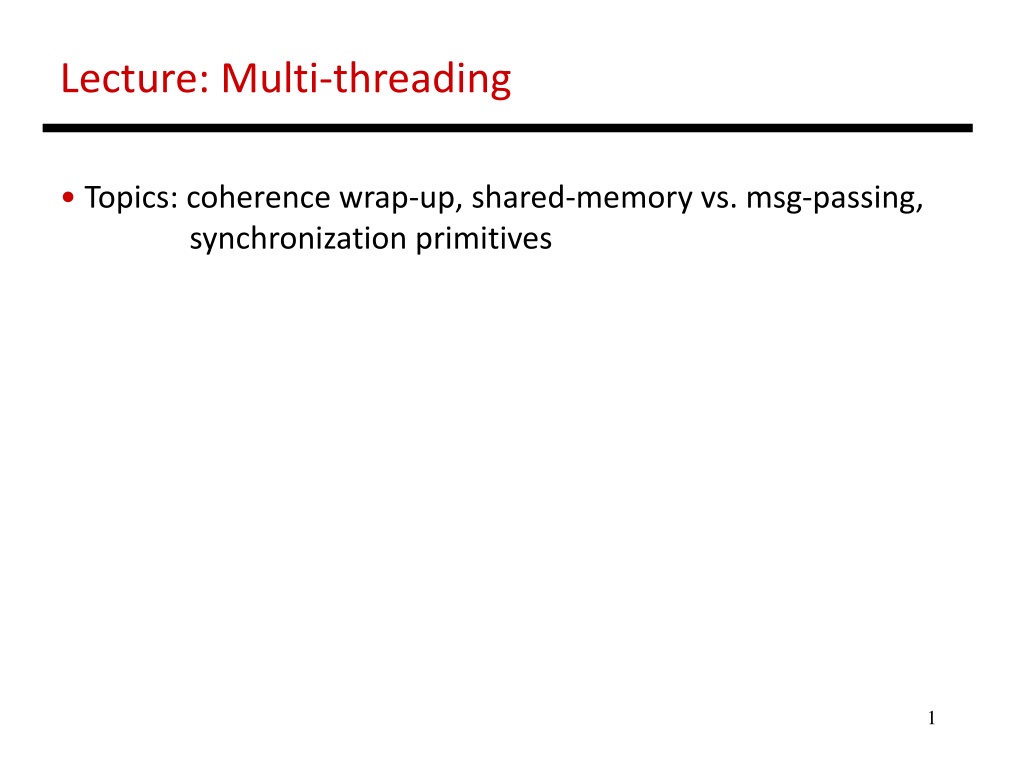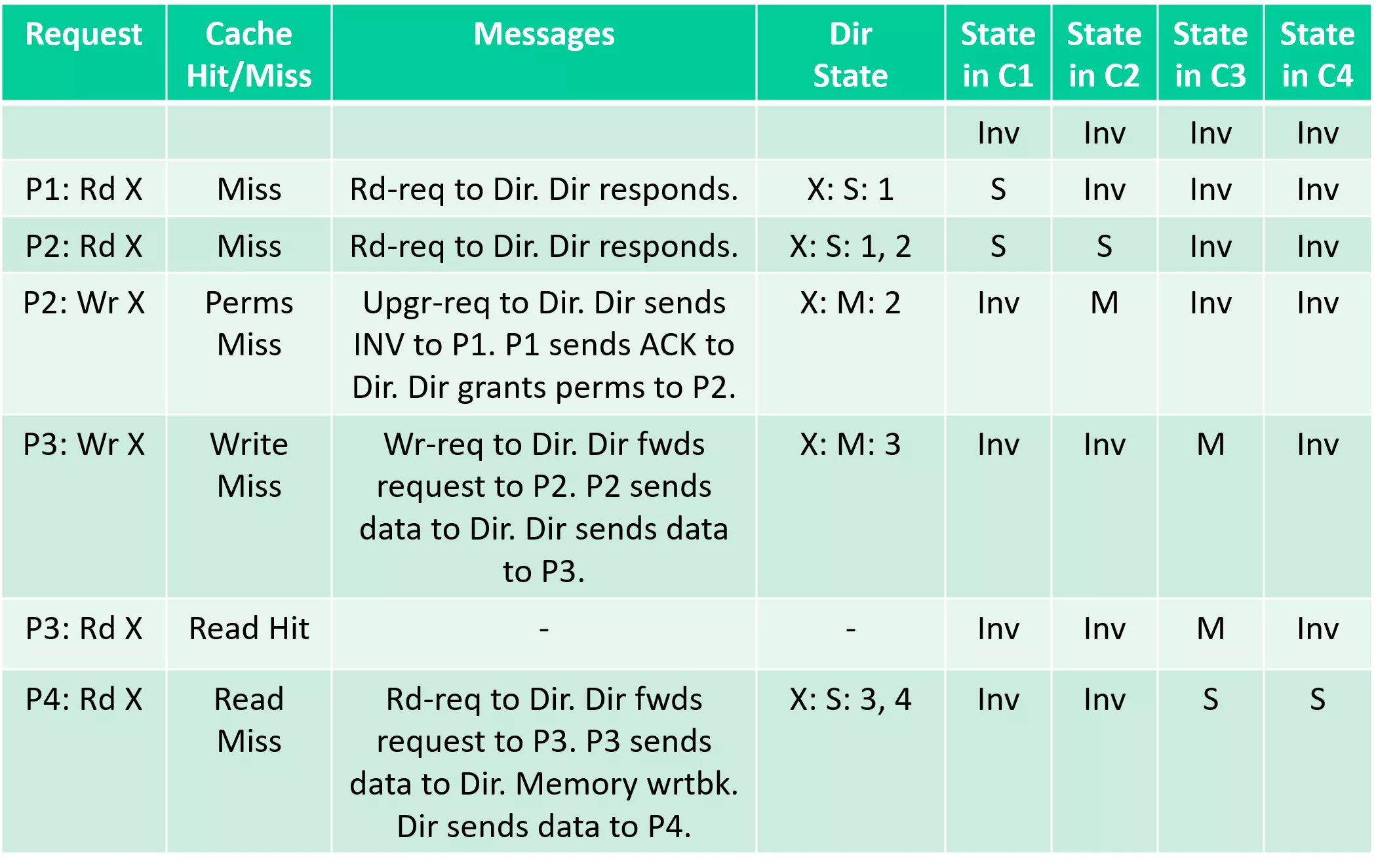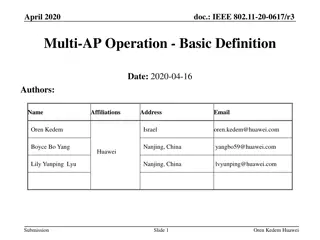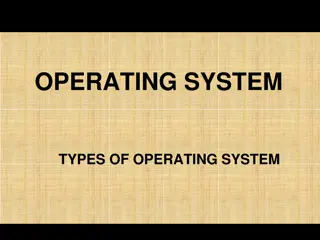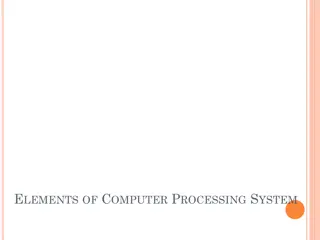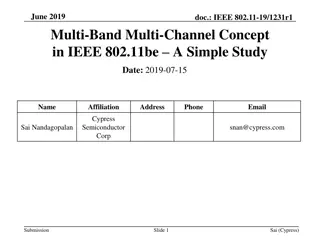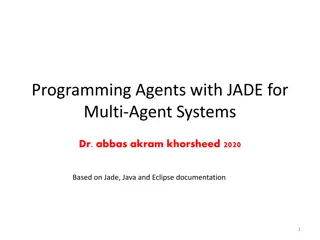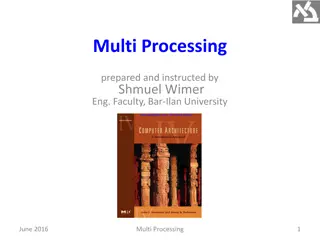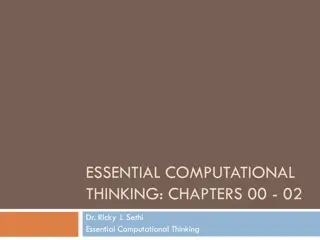Multi-Threading Concepts in Computer Systems
Exploring topics such as cache coherence, shared memory versus message passing, synchronization primitives, cache block states, performance improvements in multiprocessors, and the Ocean Kernel procedure for solving matrices.
Download Presentation

Please find below an Image/Link to download the presentation.
The content on the website is provided AS IS for your information and personal use only. It may not be sold, licensed, or shared on other websites without obtaining consent from the author. Download presentation by click this link. If you encounter any issues during the download, it is possible that the publisher has removed the file from their server.
E N D
Presentation Transcript
Lecture: Multi-threading Topics: coherence wrap-up, shared-memory vs. msg-passing, synchronization primitives 1
Directory-Based Example Request Cache Hit/Miss Messages Dir State State in C1 State in C2 State in C3 State in C4 Inv Inv Inv Inv P1: Rd X Miss Rd-req to Dir. Dir responds. X: S: 1 S Inv Inv Inv P2: Rd X Miss Rd-req to Dir. Dir responds. X: S: 1, 2 S S Inv Inv P2: Wr X Perms Miss Upgr-req to Dir. Dir sends INV to P1. P1 sends ACK to Dir. Dir grants perms to P2. X: M: 2 Inv M Inv Inv P3: Wr X Write Miss Wr-req to Dir. Dir fwds request to P2. P2 sends data to Dir. Dir sends data to P3. X: M: 3 Inv Inv M Inv P3: Rd X Read Hit - - Inv Inv M Inv P4: Rd X Read Miss Rd-req to Dir. Dir fwds request to P3. P3 sends data to Dir. Memory wrtbk. Dir sends data to P4. X: S: 3, 4 Inv Inv S S 2
Cache Block States What are the different states a block of memory can have within the directory? Note that we need information for each cache so that invalidate messages can be sent The block state is also stored in the cache for efficiency The directory now serves as the arbitrator: if multiple write attempts happen simultaneously, the directory determines the ordering 3
Performance Improvements What determines performance on a multiprocessor: What fraction of the program is parallelizable? How does memory hierarchy performance change? New form of cache miss: coherence miss such a miss would not have happened if another processor did not write to the same cache line False coherence miss: the second processor writes to a different word in the same cache line this miss would not have happened if the line size equaled one word 4
Shared-Memory Vs. Message-Passing Shared-memory: Well-understood programming model Communication is implicit and hardware handles protection Hardware-controlled caching Message-passing: No cache coherence simpler hardware Explicit communication easier for the programmer to restructure code Sender can initiate data transfer 5
Ocean Kernel Procedure Solve(A) begin diff = done = 0; while (!done) do diff = 0; for i 1 to n do for j 1 to n do temp = A[i,j]; A[i,j] 0.2 * (A[i,j] + neighbors); diff += abs(A[i,j] temp); end for end for if (diff < TOL) then done = 1; end while end procedure 6
Shared Address Space Model procedure Solve(A) int i, j, pid, done=0; float temp, mydiff=0; int mymin = 1 + (pid * n/procs); int mymax = mymin + n/nprocs -1; while (!done) do mydiff = diff = 0; BARRIER(bar1,nprocs); for i mymin to mymax for j 1 to n do endfor endfor LOCK(diff_lock); diff += mydiff; UNLOCK(diff_lock); BARRIER (bar1, nprocs); if (diff < TOL) then done = 1; BARRIER (bar1, nprocs); endwhile int n, nprocs; float **A, diff; LOCKDEC(diff_lock); BARDEC(bar1); main() begin read(n); read(nprocs); A G_MALLOC(); initialize (A); CREATE (nprocs,Solve,A); WAIT_FOR_END (nprocs); end main 7
Message Passing Model main() read(n); read(nprocs); CREATE (nprocs-1, Solve); Solve(); WAIT_FOR_END (nprocs-1); for i 1 to nn do for j 1 to n do endfor endfor if (pid != 0) SEND(mydiff, 1, 0, DIFF); RECEIVE(done, 1, 0, DONE); else for i 1 to nprocs-1 do RECEIVE(tempdiff, 1, *, DIFF); mydiff += tempdiff; endfor if (mydiff < TOL) done = 1; for i 1 to nprocs-1 do SEND(done, 1, I, DONE); endfor endif endwhile procedure Solve() int i, j, pid, nn = n/nprocs, done=0; float temp, tempdiff, mydiff = 0; myA malloc( ) initialize(myA); while (!done) do mydiff = 0; if (pid != 0) SEND(&myA[1,0], n, pid-1, ROW); if (pid != nprocs-1) SEND(&myA[nn,0], n, pid+1, ROW); if (pid != 0) RECEIVE(&myA[0,0], n, pid-1, ROW); if (pid != nprocs-1) RECEIVE(&myA[nn+1,0], n, pid+1, ROW); 8
Constructing Locks Applications have phases (consisting of many instructions) that must be executed atomically, without other parallel processes modifying the data A lock surrounding the data/code ensures that only one program can be in a critical section at a time The hardware must provide some basic primitives that allow us to construct locks with different properties Lock algorithms assume an underlying cache coherence mechanism when a process updates a lock, other processes will eventually see the update 9
Synchronization The simplest hardware primitive that greatly facilitates synchronization implementations (locks, barriers, etc.) is an atomic read-modify-write Atomic exchange: swap contents of register and memory Special case of atomic exchange: test & set: transfer memory location into register and write 1 into memory lock: t&s register, location bnz register, lock CS st location, #0 10
Caching Locks Spin lock: to acquire a lock, a process may enter an infinite loop that keeps attempting a read-modify till it succeeds If the lock is in memory, there is heavy bus traffic other processes make little forward progress Locks can be cached: cache coherence ensures that a lock update is seen by other processors the process that acquires the lock in exclusive state gets to update the lock first spin on a local copy the external bus sees little traffic 11
Coherence Traffic for a Lock If every process spins on an exchange, every exchange instruction will attempt a write many invalidates and the locked value keeps changing ownership Hence, each process keeps reading the lock value a read does not generate coherence traffic and every process spins on its locally cached copy When the lock owner releases the lock by writing a 0, other copies are invalidated, each spinning process generates a read miss, acquires a new copy, sees the 0, attempts an exchange (requires acquiring the block in exclusive state so the write can happen), first process to acquire the block in exclusive state acquires the lock, others keep spinning 12
Test-and-Test-and-Set lock: test register, location bnz register, lock t&s register, location bnz register, lock CS st location, #0 13
Load-Linked and Store Conditional LL-SC is an implementation of atomic read-modify-write with very high flexibility LL: read a value and update a table indicating you have read this address, then perform any amount of computation SC: attempt to store a result into the same memory location, the store will succeed only if the table indicates that no other process attempted a store since the local LL (success only if the operation was effectively atomic) SC implementations do not generate bus traffic if the SC fails hence, more efficient than test&test&set 14
Spin Lock with Low Coherence Traffic lockit: LL R2, 0(R1) ; load linked, generates no coherence traffic BNEZ R2, lockit ; not available, keep spinning DADDUI R2, R0, #1 ; put value 1 in R2 SC R2, 0(R1) ; store-conditional succeeds if no one ; updated the lock since the last LL BEQZ R2, lockit ; confirm that SC succeeded, else keep trying If there are i processes waiting for the lock, how many bus transactions happen? 15
Spin Lock with Low Coherence Traffic lockit: LL R2, 0(R1) ; load linked, generates no coherence traffic BNEZ R2, lockit ; not available, keep spinning DADDUI R2, R0, #1 ; put value 1 in R2 SC R2, 0(R1) ; store-conditional succeeds if no one ; updated the lock since the last LL BEQZ R2, lockit ; confirm that SC succeeded, else keep trying If there are i processes waiting for the lock, how many bus transactions happen? 1 write by the releaser + i (or 1) read-miss requests + i (or 1) responses + 1 write by acquirer + 0 (i-1 failed SCs) + i-1 (or 1) read-miss requests + i-1 (or 1) responses (The i/i-1 read misses and responses can be reduced to 1) 16
Further Reducing Bandwidth Needs Ticket lock: every arriving process atomically picks up a ticket and increments the ticket counter (with an LL-SC), the process then keeps checking the now-serving variable to see if its turn has arrived, after finishing its turn it increments the now-serving variable Array-Based lock: instead of using a now-serving variable, use a now-serving array and each process waits on a different variable fair, low latency, low bandwidth, high scalability, but higher storage Queueing locks: the directory controller keeps track of the order in which requests arrived when the lock is available, it is passed to the next in line (only one process sees the invalidate and update) 17
Lock Vs. Optimistic Concurrency lockit: LL R2, 0(R1) BNEZ R2, lockit DADDUI R2, R0, #1 SC R2, 0(R1) BEQZ R2, lockit Critical Section ST 0(R1), #0 LL-SC is being used to figure out if we were able to acquire the lock without anyone interfering we then enter the critical section If the critical section only involves one memory location, the critical section can be captured within the LL-SC instead of spinning on the lock acquire, you may now be spinning trying to atomically execute the CS tryagain: LL R2, 0(R1) DADDUI R2, R2, R3 SC R2, 0(R1) BEQZ R2, tryagain 18
Barriers Barriers are synchronization primitives that ensure that some processes do not outrun others if a process reaches a barrier, it has to wait until every process reaches the barrier When a process reaches a barrier, it acquires a lock and increments a counter that tracks the number of processes that have reached the barrier it then spins on a value that gets set by the last arriving process Must also make sure that every process leaves the spinning state before one of the processes reaches the next barrier 19
Barrier Implementation LOCK(bar.lock); if (bar.counter == 0) bar.flag = 0; mycount = bar.counter++; UNLOCK(bar.lock); if (mycount == p) { bar.counter = 0; bar.flag = 1; } else while (bar.flag == 0) { }; 20
Sense-Reversing Barrier Implementation local_sense = !(local_sense); LOCK(bar.lock); mycount = bar.counter++; UNLOCK(bar.lock); if (mycount == p) { bar.counter = 0; bar.flag = local_sense; } else { while (bar.flag != local_sense) { }; } 21
